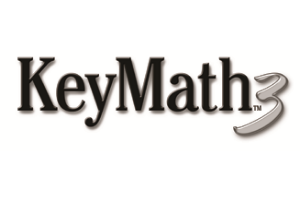

KeyMath™-3 Diagnostic Assessment is an individually administered measure of essential mathematical concepts and skills. It consists of three linked components: The updated KeyMath 3 Diagnostic Assessment, ASSIST™ Scoring and Reporting Software, and the KeyMath 3 Essential Resources instructional program.
KeyMath™-3 Diagnostic Assessment is an individually administered measure of essential mathematical concepts and skills. It consists of three linked components: The updated KeyMath 3 Diagnostic Assessment, ASSIST™ Scoring and Reporting Software, and the KeyMath 3 Essential Resources instructional program.
Author:Austin J. Connolly, EdD
Overview:
Individually administered measure of essential mathematical concepts and skills
Age Range:
4:6-21:11; Grades K-12
Administration:
Scoring Option:
ASSIST™ Software or Manual Scoring
RTI Tiers:
RTI Levels 2 and 3
Completion Time:
30 to 90 minutes
Scores/Interpretation:
Areas and Total Test: Grade-and age-based standard scores (M=100, SD=15), grade and age equivalents, percentile ranks and Growth Scale Values. Subtests: Grade- and age-based scale scores (M=10, SD=3), and grade and age equivalents.
Publication Date:
The KeyMath 3 assessment and instruction system gives you tools to assess and improve math skills of students ages 4½ – 21. This is a comprehensive system consisting of 3 linked components:
The KeyMath 3 Diagnostic Assessment (KeyMath 3 DA) is a comprehensive, norm-referenced measure of essential mathematical concepts and skills. Like previous versions of the widely used KeyMath assessments this addition to the KeyMath family is untimed and individually administered. However, the KeyMath 3 DA represents a substantial revision in concept and design, including:
The items are grouped into 10 subtests that represent three general math content areas
KeyMath 3 DA content covers the full spectrum of math concepts and skills that are typically taught in kindergarten through ninth grade and can be used with individuals aged 4½ through 21 years who are functioning at these instructional levels. It is available in two parallel forms, designated as Form A and Form B, each of which contains 372 full-color test items.
Each area is further divided into subtests (see Table 1 below), with the content of each subtest spanning kindergarten through eighth- or ninth-grade math curricula. The five basic concepts subtests parallel the five content standards of the National Council of Teachers of Mathematics (NCTM). Much like the NCTM Focal Points, the content of the basic concepts subtests represents a carefully selected set of concepts and skills at each grade level that form the foundation for mathematics learning and connections across subtests. In addition, the KeyMath 3 assessment places more emphasis on math communication, connections, and reasoning than does the KeyMath Revised version (published in 1988).
Unlike the NCTM standards, which embed math operations in the numeration strand, the KeyMath 3 assessment includes two separate written computation subtests (Addition and Subtraction; Multiplication and Division). Operations skills are fundamental for success in mathematics and are often the source of math learning difficulties. By providing separate measures of operational skills, the KeyMath 3 assessment is able to focus particular attention in this important area.
The two applications subtests assess a student’s ability to apply conceptual knowledge and operational skills to solve math problems. The Foundations of Problem Solving subtest includes items that require students to identify missing elements in a problem, operations needed to solve a problem, and optimal strategies for solving the problem. The Applied Problem Solving subtest presents math problems in real-world contexts and includes items that require standard and nonstandard problem-solving strategies.
Table 1: KeyMath 3 Areas, Subtests, and Item Counts
| Area and subtest | No. of items |
| Basic concepts Numeration Algebra Geometry Measurement Data Analysis and Probability | 49 39 36 40 40 |
| Operations Mental Computation and Estimation Written Computation: Addition and Subtraction Written Computation: Multiplication and Division | 40 35 31 |
| Applications Foundations of Problem Solving Applied Problem Solving | 27 35 |
Sample items from three selected subtests are available for your review; Algebra, Mental Computation and Estimation, and Applied Problem Solving. Although these are not actual items from the assessment they are similar to items in the assessment and represent the type of content included in the KeyMath 3 Diagnostic Assessment. Content spans first through eighth grade and demonstrates the broad scope of the assessment.
The KeyMath 3 DA has a substantial advantage over its predecessors in that it provides a means of monitoring an individual’s progress over time. It includes two parallel forms (Form A and Form B), which can be administered in alternating sequence every 3 months, as well as growth scale values (GSVs), which are a type of developmental scale score. GSVs enable users to accurately measure progress across the full range of math concepts and skills. The KeyMath–3 DA ASSIST software application can be used to automatically generate a Progress Report, which (a) shows the amount of change across test administrations, (b) indicates whether an individual has made measurable progress, and (c) compares an individual’s growth rate with the average growth rate of the representative population.
A large sample, consisting of approximately 4,000 individuals representing U.S. demographics by sex, race, socioeconomic status, region, and disability condition, was used to obtain normative data. The norm sample ranges in age from 4 years 5 months through 21 years 11 months. Both age norms and grade (kindergarten – grade 12, fall and spring) norms are available.
Several types of norm-referenced scores are provided, including scale and standard scores, percentiles, age and grade equivalents, and growth values.
Windows XP, Vista & Mac OS only